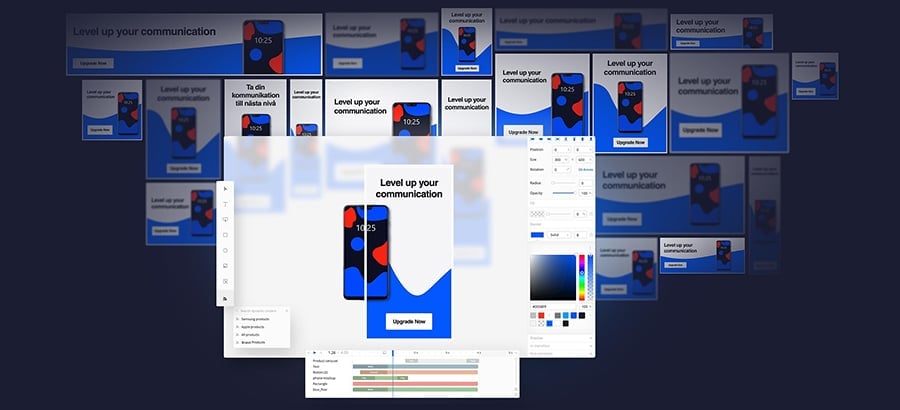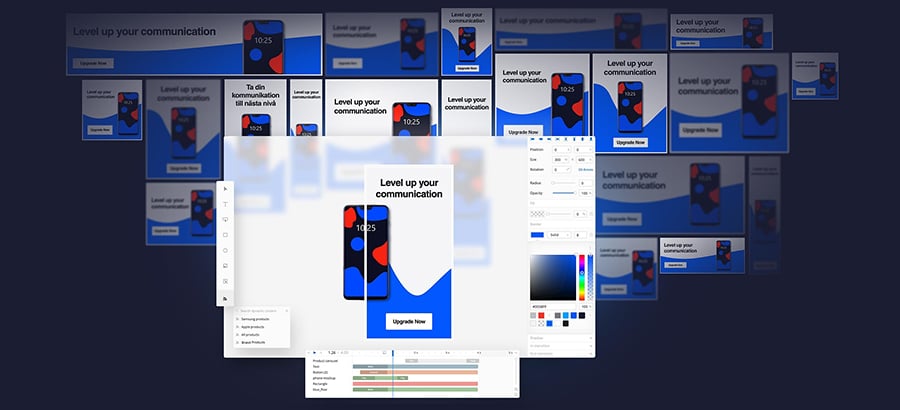
Marketing Tools: 5 Essential Ones to Make Your Life Easier
You can’t please everyone all of the time. However, as a marketer, it’s your job to try and use marketing tools to disprove this age old John Lydgate quote (if you’re curious, he was a poet), and get absolutely everyone interested in what you have to say.
Sure, you can’t sell your product to everyone, but the more who know about it, and like your brand, the more exposure you’ll get. In the longer term, this means more leads will trickle through and convert into precious sales.
Sounds tough? Well, for the most part, it is. Thankfully, there are hundreds, if not thousands of marketing tools to help you in every part of the process. From planning right through to display advertising tools, there is software designed specifically to make your life easier.
It can be overwhelming to dig through all the available software, so we compiled a list just for you. Here, we take a look at the best marketing tools for each task facing marketers today.
1. Planning
A vital part of any marketer’s job is the planning. It’s the foundation that everything else is built on, so you need to be sure you’re getting this part right. We wrote about how planning used to be one of our biggest sticking points, so we had to change the way we worked.
After looking at a few options for software which were designed to help organise the process, we finally landed on one which was intuitive, well designed, and simple.
That program is Trello.
For those unfamiliar, Trello is essentially a digital organisation board where you can break bigger tasks down into individual steps, and assign steps to different members of your team. On the surface, it’s super simple to use, but the more familiar you get with the tool, the more you realise how flexible and deep it can be.
One huge benefit we found is that what seems like a huge, complicated task at the beginning can look really simple and manageable when it’s all broken down, and assigned to the different team members.
Deadlines are easily applied, and there’s a satisfying flow to this marketing tool. Once you set a flow for your workload (planning, in progress, awaiting authorisation, and complete, for example), it’s oh-so-satisfying moving the task cards along, until they reach the complete column. Then, when the cards in ‘complete’ start to stack up, you can proudly look back on all you’ve achieved.
Only for a second though…you’ve got to move on to your next project now. The Trello board says so.
Some alternatives:
While neither of these are marketing tools in the strictest sense, they help marketers to work in a more agile, efficient way.
Jira – A little more complicated and in depth than Trello, and slightly more difficult to get to grips with at first. Once you learn the system, though, it’s flexible, deep and intuitive, and a viable alternative.
Asana – This is a wide-ranging project management tool, used by the likes of Uber and The New Yorker. A well designed, easy-to-use platform, that is more focused on pushing projects forward and maintaining cross-team communication.
2. Social media advertising
If you want to be where your audience is, some sort of presence on social media is absolutely essential. Now there are options and advertising tools on every major social platform too, so you can access a wide range of totally different demographics.
The best tool is really dependent on which network is best for your particular audience. If you’re selling direct to customers, Facebook is fantastic. If you’re a business to business…business, LinkedIn is a good bet. If you’re selling clothes, or something more visual, Instagram works really well. The article on Venturebeat describes their first foray into Instagram ads returning more than ten times the engagement of a similar ad on other social channels.
Overall, though, which marketing tool works best, and makes advertising on social media a breeze?
That would have to be Facebook.
Firstly, it’s the network with the biggest user base. As well as having over a billion users, most businesses can be found on there.
Secondly, it’s really simple to advertise. The programmatic options are extensive, and you can drill down into really fine detail based on user behaviours and tastes, but to actually publish and target an ad, it couldn’t be easier. It’s all self-explanatory and intuitive.
Thirdly, it allows you to advertise all over the web by checking a single option. The Facebook network is extensive, and means your ad will be seen on a huge number of different sites, as well as Facebook itself. If you want it to, of course.
There are options whatever your budget and the reach can be astounding.
Protip – you don’t have to do it all manually. You can manage and schedule your posts through various apps and programs. We use Hubspot, and it has made it incredibly easy to ensure we are active on all social networks regularly, without having to constantly hit the post button. Edgar and Buffer are great for this too.
Some alternatives:
LinkedIn – Great for advertising business to business, the way you advertise is similar to Facebook. The analytics are solid, too.
Instagram – Technically part of Facebook, but the advertising opportunities here are very different. Great if you have a product best presented in image or video.
3. Display Advertising Tools
When it comes to online display advertising, there is a whole host of display advertising tools out there to help you. Even if you focus solely on the production of banner ads, a number of options can seem almost staggering.
What are the most important things to look for in a display advertising marketing tool?
The display advertising tool or ad creator needs to be easy to use, and intuitive. It also needs to produce all ads in HTML5. From there, you want to be able to implement video, animations, and rich media quickly and easily. You also need to be able to create a number of different sizes and translations ideally with just a few clicks, so you can scale your ads without any hassle.
From there, the tool needs to be able to publish your ads with minimum fuss, and you need to be able to edit your ads after publishing if necessary.
Which display advertising tool can do all of this, and more?

It’s an incredibly powerful tool, but one that’s easy to use. Everything is in HTML5, and scaling up campaigns takes a matter of minutes.
Through Direct Publishing, you can get your banner ads out to more than 20 of the biggest ad networks, and in front of your audience, in just a few clicks.
The variety of banners you can create is huge, too. Whether you want to use video, rich media, or animated widgets, all you need to do is drag and drop the appropriate module onto the canvas. You can find out more about Bannerflow here. It’s already changed the way our customers work for the better.
DC Thomson, a media agency, said “BannerFlow allows us to sell sophisticated ad campaigns and enables our designers to be more creative when executing conceptual ideas. This also empowers our sales executives and gives them the tools to compete at a local level delivering artwork on a par with a high-end agency.”
4. Content Marketing
With content marketing tools, it’s not so much about which platform you use to produce it, but more how you draw attention to yourself.
Tools for production, after all, can be as simple as typing in Google docs, or even using a notepad. At Bannerflow, we use Google docs extensively in the marketing team, as it’s so easy to share and comment on documents. This means it’s quick and efficient for other team members to edit articles before publishing.
The most important aspect of content marketing is actually getting your content out to the masses. Of course, you can do this through promoting content on your social channels, and via email, but there are tools out there to help you get your content out to a variety of audiences without any trouble.
There are solutions and tools which can help if you don’t have the time to produce your own content, too but are looking to use this marketing method to raise the profile of your business.
The recommended tool for this part of marketing is Contently.
It’s a tool which can help you in every aspect of content marketing. They have a creation tool, which is clean and easy to use and allows for others to leave notes and authorise your work if needed.
If you need help with the actual creation, there’s access to a huge bank of freelancers ready to write great content relating to your business as well.
From there, it’s easy to publish across many different channels like blogs and social networks, and their analytics tool is great for tracking how well the content is doing.
This is a great tool for all marketers, from those just starting with content marketing to the more experienced writers out there.
Some alternatives:
Outbrain – You will have no doubt seen promoted articles from Outbrain. They allow you to push your writing all over the web as native content, expanding your reach immediately.
Curata – This software is focussed on content curation, as the name suggests. Not only does it facilitate your own content creation, but it helps you discover the things you’re interested in.
5. Email Marketing
Despite what you might hear and see, email marketing is very much alive and well. In fact, over half of all respondents to this survey actually preferred companies to contact them via email over any other method.
What are the things to look for in an email marketing tool? There are quite a few things to consider.
A private IP address is necessary to overcome being blocked by spam filters. Also, a simple but flexible creation tool can help save huge amounts of time, and also allows you to develop a certain theme and tone with your emails.
As an aside, it’s a good idea to have some general guidelines laid out in your email strategy. This should include the fact that you always need permission from the user before you start emailing them, and a strict policy on how many times to email per week or month. You don’t want to spam people with endless emails, as they will just unsubscribe.
The analytics also needs to be robust enough to allow you to see how to optimise future campaigns, and you ideally can segment your database, and send different emails to different audiences based on their buyer profiles.
A few email marketing tools have these capabilities, but one tends to stand out from the rest, both in its branding and its user base: Mailchimp.
They have over 15m customers and look to be growing all the time. The tool is intuitive, and the user experience is a pleasant one. They also have features like recommended times to send emails, as well as reports which let you see how much actual revenue your email campaigns produce.
They continue to add to their offering too, so it’s more than just an email tool. Although, this is still the core of the product and the most impressive part. It helps that the branding is great, too.
If you want to get more advanced in your email marketing, you can set automated processes which send specific emails to your different audiences and segments when they complete specific actions. This helps you move every user further towards becoming a customer, without the time-consuming manual input.
Some alternatives:
Hubspot – this is a wide-ranging marketing tool, great for full-scale marketing automation. A part of that is the email platform, which is a useful facet of the program, and one we use extensively.
EasySendy – A cost-efficient alternative to Mailchimp, which still offers segmentation functionality and guidance on email marketing best practices.
Final thoughts
Whatever your plan for marketing, there’s a whole world (wide web) of tools out there to make your life easier. From planning all the way through to publishing, and everything in between, all of this software is designed to make our lives easier.
It always helps to test which ones work best for you, but thankfully most have the option of a free trial. To sign up to Bannerflow’s, click here!
Share this article







